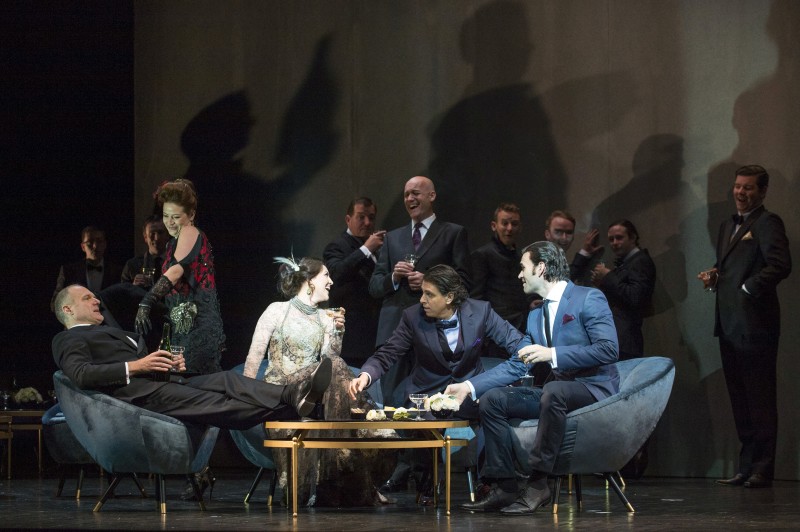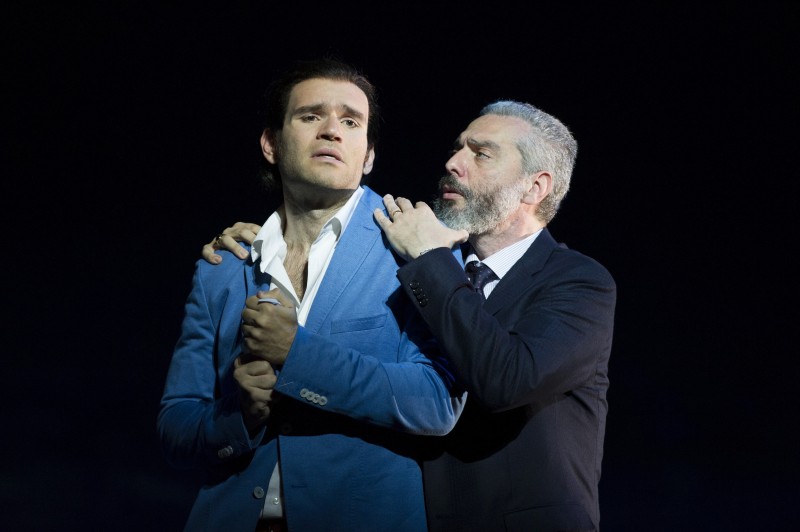La Traviata, Glyndebourne, GFO, July 2014
Posted on 18 July 2014A careful attention to musical detail renders this new, fairly minimalist production of Traviata by Tom Cairns extremely effective, helped enormously by the stunning performance of Venera Gimadieva as Violetta.

Opening party scene: Baron, Violetta, Gastone, Alfredo; all images Richard Hubert Smith
Her softness and richness of tone reminded me of Ileana Cotrubas as she subtly brought Violetta’s multi-faceted character into play. In Act I after an introspective and magical A quell’amor ch’è palpito, about love being the pulse of the world, she immediately recovers her pretty teasing manner only to let a bottle drop to the floor as she hears Alfredo’s Amor è palpito off-stage.
Then in the first scene of Act II her duet with Alfredo’s father Germont produced vibrant emotion, with Tassis Christoyannis as Germont cleverly warming the tone of his voice as he begins to see the true character of this young woman. When she sings of wanting only Alfredo (Lui solo amar vogl’io) he finally takes off his coat and sits with her — such small details illustrate how well this production fits action to music. After Germont mentions his daughter’s future happiness, Violetta turns away and her words float on the air, seeming to come from the heavens above.

Alfredo and his father
Superb support from the orchestra under the baton of Mark Elder, and after Alfredo has shown his confusion later in that scene, Elder built up tremendous power for her Amami Alfredo (Love me Alfredo), softly delivered with huge emotion. Alfredo himself was sung with great strength and fine diction by Michael Fabiano, displaying huge enthusiasm, passion, and confusion. After Violetta has left for Paris his duet with his father was full of tension, and his fury after hastily reading her letter showed a lover completely out of his depth.

Violetta welcomes Alfredo at last
Tom Cairns has brought ample male confusion to this story with the excellent Eddie Wade bringing forceful masculinity to the role of the Baron. Feet arrogantly on the table in Act I, his confused concern in the Act II party scene was only outclassed in angry gravitas by the appearance of Germont. Fine performances too from the women with Hanna Hipp as a cheerful Flora who cannot bear to see her friend dying at the end — she comes briefly on stage and leaves again — and Magdalena Molendowska was gloriously sympathetic and self-effacing as Violetta’s maid Annina.
Wonderful lighting by Peter Mumford, particularly in the Act II party scene where purple, green and red span the stage, and everything cleverly dims towards the end. Video projections of clouds by Nina Dunn lighten the Act II scene at Violetta’s country house, and Hildegard Bechtler’s costumes span a variety of periods from the beginning of the twentieth century to modern times. Violetta’s dress at the start is in Edwardian style, some of the men’s smart clothing is absolutely up to date, and the doctor’s brown coat, which makes him appear more vet than médecin, looks very much 1960s.
In the overture and the prelude to Act III things are seen dimly behind a front screen, and in the denouement everyone quietly leaves the stage to the solitary figure of Violetta, when suddenly … But you have to see it.
Among the fine Violetta’s in the world today, Venera Gimadieva is surely up there with the best. Her interaction with Graeme Broadbent’s doctor was beautifully portrayed as she accepts his false assurances, and those ethereal floating notes of hers return to tell us that here is a young woman on the final journey of her brief life. Wonderful!
Performances continue on various dates until August 23 with a live screening to the web and cinemas on August 10 — for details click here.

